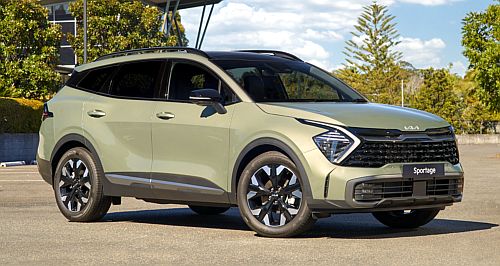Kia confirms RAV4 hybrid fighter

TOYOTA will have yet another hybrid rival to its RAV4 midsize SUV from early next year, with Kia Australia confirming it will finally add a petrol-electric hybrid (HEV) version of its Sportage medium SUV in 2024.
Due to go on sale in the first few months of 2024, the hybrid Kia Sportage will be offered in the same body size, and from the same production facility, as the ‘standard’ Sportage models, which are offered with non-hybrid petrol and diesel engines.
Until now, the hybrid Sportage has been restricted to the European market and were constructed in Slovakia in the shorter-wheelbase Euro-spec body size, not the maxi-Sportage model we get in Australia (as is also offered in South Korea and other Australiasian markets).
Kia Australia general manager of product planning and training, Roland Rivero, confirmed the news this week at a media event.
“We’re adding another powertrain to the Sportage range in quarter one 2024. It will be sourced out of Korea, so it will be the long-wheelbase. Europe will continue to supply their market from Slovakia,” said Mr Rivero.
“And there will be better supply out of what you’ve seen with Sorento, so that could make for a couple of variants,” he said, referring to the somewhat limited availability of the Sorento petrol-electric models. That larger SUV is offered with both hybrid and plug-in hybrid options.
The Sportage HEV will be offered without a plug, following the lead of the incredibly popular RAV4 hybrid.
As for the powertrain itself, expect it to mirror what is already available in the Sorento model - a 1.6-litre turbo-petrol engine with a ‘parallel’ hybrid system. The petrol engine produces 132kW of power and 265Nm of torque, and is paired with an electric motor (producing 44kW and 264Nm). The electric motor is mounted in between the petrol engine and the six-speed dual-clutch auto transmission.
It has a 1.49kWh lithium-ion polymer battery, and the brand has stated that total system outputs are sizable, at 169kW and 350Nm, making the Sportage hybrid one of the most powerful options in the segment.
It’s unclear if the versions sold in Australia will be front- or all-wheel drive, as both are available in other markets. That could, perhaps, be part of the differentiation between the two variants offered, as well as pricing, which Mr Rivero suggests will be crucial, but won’t mean the brand will be able to offer nearly as many choices as you’ll find in the Toyota RAV4 hybrid line-up – nine of the 13 variants offered in that range are hybrid, where it’s likely the Sportage 2024 line-up will have two hybrids and a remaining mix of at least 10 petrol and diesel models.
“It won’t be anywhere near RAV4 in terms of model mix, we won’t get that kind of volume in supply. Probably, just shy of 200 a month,” said Mr Rivero.
He further raised one of the biggest criticisms of the Sorento hybrid and PHEV models, that they are only offered specifically in GT-Line trim - so, they’re the most expensive Sorentos you can buy.
“The question I’ve been asked is ‘why has Sorento only ever been offered as a GT-Line?’ and I think everyone can answer that question without asking any further that the supply dictates that.
“But the supply for Sportage will be a lot healthier, and with that healthier supply we can potentially open up not only to private buyers, but we may be able to open up to fleet customers,” he said.
“We’ve only been able to get a sprinkling of Sorento hybrids, but it won’t be the same case for Sportage. Sportage will be healthier,” said Mr Rivero.
However, he hinted that there are still ongoing component supply constraints that could impact not only the hybrid models, but all Sportages.
“Mind you we’re going through some issues with Sportage in terms of components - if it’s not Harman Kardon, it’s safety windows or what have you. In the biggest segment in the market,” he said.
Kia has underperformed, by its own admission, in the midsize SUV segment in terms of sales performance in 2023 so far.
The brand has shifted 5332 Sportages to the end of May, down 20.7 per cent on last year’s figures. Supply is the issue, says Kia, though it has meant that a number of rivals have streaked ahead so far in 2023.
For context, the best-selling midsize SUV to the end of May 2023 remains the Toyota RAV4 (10,665 units), followed by the Mazda CX-5 (9795 units), Mitsubishi Outlander (9718 units), Hyundai Tucson (8082) and Subaru Forester (6885).